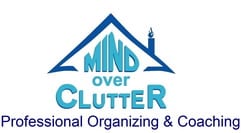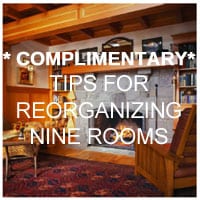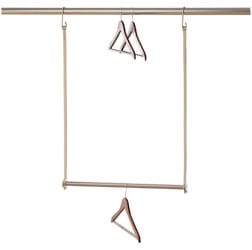9 Tips for organizing with children in mind
Reading time – 5 minutes
With school out for summer and children around more of the time think about organizing things so they can keep their stuff put away. Too many times children can only do half of the job because the shelf is too high for them to reach and an adult needs to finish the job. Organize things so they can do the entire job of putting things away or getting things out. It will be less frustrating for everyone.
1. Place hooks so children can reach them and as children grow, the placement of their items should change with their higher reach.
2. Organizing items for children to use should be kept within their reach. If a child constantly needs help accessing these items this will cause frustration for both parent and child. Keep books, toys, dishes, coat hooks, clothes closet bars and towels at age/size-appropriate level.
3. Designate a place for sporting gear, helmets, pads, shoes etc. It may be a shelf or a pegboard with hooks or a mess bag. These 3 options allow the sporting gear to dry out before the next usage. It is important to air out damp items so they don’t get mouldy. When the children arrive home they won’t need to ask a parent what to do with their stuff and when an adult asks them to get ready they can easily collect everything they need. No more piles of gear left on the floor by the door.
4. Establish a routine for water bottles and lunch bags. Make sure the children know how to empty and recycle items from their lunch bag and where to put the bag for storing or use the next day. Do water bottles need to be washed every day or refilled? What is the rule in your household?
5. Wet swimwear needs to be hung up and dried or washed. Make a place for towels to be hung and bathing suits to be dried. Teach your children to wring out or roll their bathing suit in their towel before hanging it up. This will prevent a puddle of water from forming on the floor. Placing swimwear and towels on a hanger to dry may be easier to reach than putting it on a line. You may want to set up a portable clothes drier so it is easy for the children to reach.
6. Remember to always keep cleaning supplies and medicines out of the reach of children.
7. If children are permitted to use the microwave oven unsupervised, place the unit at a height where children can remove food easily without climbing on counters or standing on chairs. This will help prevent injuries from hot food spilling on the child or a child falling.
8. Label bins, drawers, and shelves with pictures or words to make tidying up quick and easy.
9. Establish a bulletin board, magnet board, or a wall covered with magnetic paint as an area to display children’s work. As new work comes home, remove items from the display area and put them in a box. When the school year is over, go through the box and decide which pieces to save and put away and which to recycle.
Did I miss anything? Let me know in the comments.
 Julie Stobbe is a Trained Professional Organizer and Lifestyle Organizing Coach who brings happiness to homes and organization to offices, in person and virtually. She has been working with clients since 2006 to provide customized organizing solutions to suit their individual needs and situation. She uses her love of physical activity to reduce clutter, in your home and office. She guides and supports you to manage your time. If you’re in a difficult transition Julie can coach you to break free of emotional clutter constraining you from living life on your terms. Online courses are available to help instruct, coach and support your organizing projects. Get started by downloading Tips for Reorganizing 9 Rooms.
Julie Stobbe is a Trained Professional Organizer and Lifestyle Organizing Coach who brings happiness to homes and organization to offices, in person and virtually. She has been working with clients since 2006 to provide customized organizing solutions to suit their individual needs and situation. She uses her love of physical activity to reduce clutter, in your home and office. She guides and supports you to manage your time. If you’re in a difficult transition Julie can coach you to break free of emotional clutter constraining you from living life on your terms. Online courses are available to help instruct, coach and support your organizing projects. Get started by downloading Tips for Reorganizing 9 Rooms.
Contact her at julie@mindoverclutter.ca
Click here to learn more about her online course Create an Organized Home.
Twitter – Facebook – Facebook group Organizing Mind and Space







Great tips. I always tell my clients that a solution has to be easy for kids to maintain, otherwise they either can’t or won’t do it. I like bins in the garage for shoes as opposed to shelves. And hooks at their height are a must! Great list.
Easy solutions is very important. As well as making sure that you have explained each step of the process. Many parents say clean your room. That means different things to the parent and the child. Make a list of tasks,
Along with these great tips, I suggest making sure your kids understand your organizing system and your expectations.
I like that you said expectations. It is important that the child knows when and how the task needs to be done for it to be considered complete.
Good tips, Julie! I agree with Janet – teach your children the how to do whatever first. Then guide them to do the task. Also, do not undermine their efforts by going back in and “fixing” the way in which they have completed the task.
It is so important not to fix what they have done. If it needs fixing get them to do it. Don’t expect perfection the first time, expect them to get better and better at the task as they learn how to do it.
Over the years, revisiting these areas to modify the systems for the growing child is key. When they are smaller, using open bins categorized by task works great, but more complex systems may be in order when they get older. Great post! You hit on a lot of points in a comprehensive post. Thank you.
Also when they get older I would let them choose the task they wanted to do each week instead of having to do the same thing each week. This helped them to learn a lot of tasks but not need a lot of time each week. Over the course of a month they would have washed floors, cleaned bathrooms, dusted, taken out the garbage, set the table, cleaned up after a meal, washed the dishes and been responsible for their own bedroom.
These are terrific tips, Julie. Parents can play such an integral role in teaching their children organizing skills, which are skills they’ll use for life. One of the things we found helpful when with our daughters, was to have a separate bin for each child they dropped their completed school and artwork into each day. We would go through it periodically during the school year to edit. But in the summer, I would hand them their bins, and help them to sort. They selected the pieces that were most important to them “the keepers,” and I would put them into a big envelope with their name, grade, and school year dates. The envelope was stored in their memory boxes. Before they went off to college, they went through those boxes and edited once more, but also enjoyed looking at their writing, drawings, and work from preschool through high school.
That is good system for all the artwork and paper that comes home from school. Some people use a clean pizza box to hold the papers and label them. I kept one file folder for each grade. My children were not interested in keeping anything from the collection.
Julie,
Thank you so much for these great tips and reminders. Putting kids items within reach is so important and yet families forgot to do this – mostly because it’s hard to keep up with children’s developmental phases (suddenly they are old enough to do something- where did the time go?!). I would add that recognizing that each child has different abilities and needs is also important. And scaffolding or meeting a child where they are developmentally is key. So, for example, one child might be able to put away their clothes in a drawer once cleaned. Another child, might only be able to put their clothes in a clean clothes hamper. And yet another, can wash, dry, fold and put their clothes away.